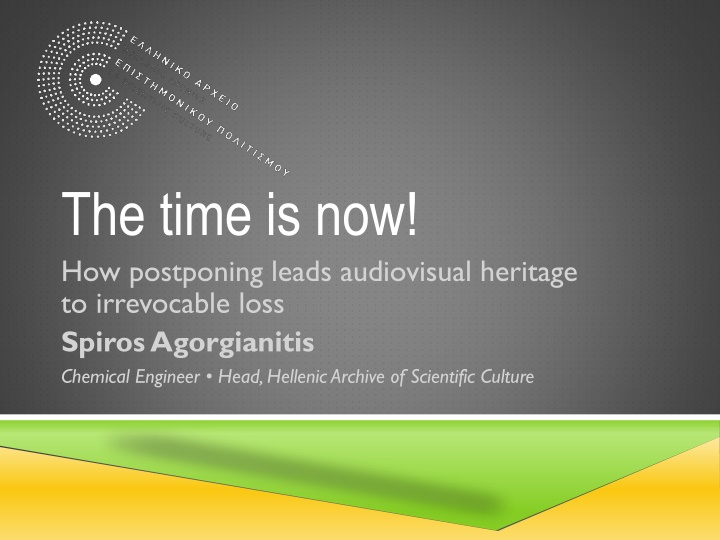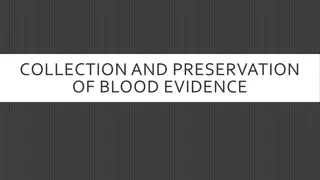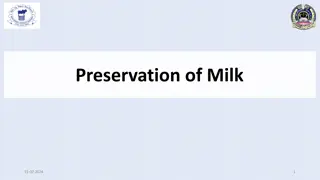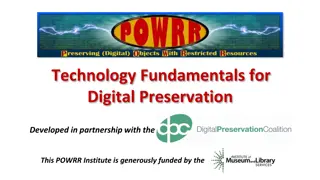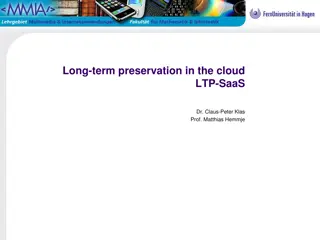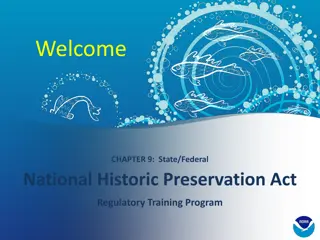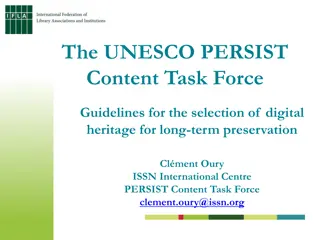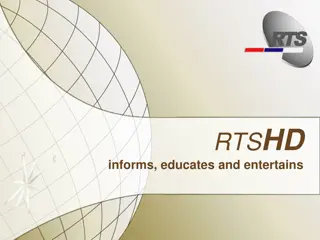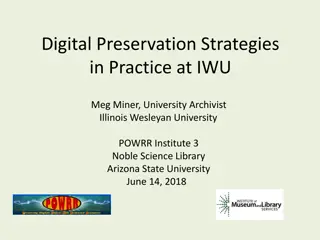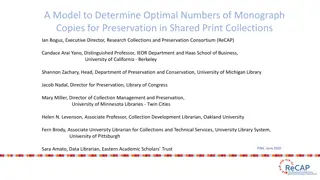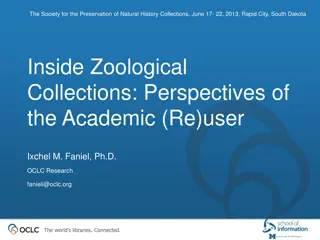The Time is Now: Urgency of Audiovisual Preservation
Postponing digital preservation of audiovisual heritage can lead to irreversible loss. The urgency lies in the deteriorating nature of audiovisual media and the necessity of digitization for long-term preservation. Challenges include lack of awareness, obsolescence of playback equipment, and excuses such as cost and expertise required. The digital age demands immediate action to safeguard our cultural assets.
Download Presentation

Please find below an Image/Link to download the presentation.
The content on the website is provided AS IS for your information and personal use only. It may not be sold, licensed, or shared on other websites without obtaining consent from the author.If you encounter any issues during the download, it is possible that the publisher has removed the file from their server.
You are allowed to download the files provided on this website for personal or commercial use, subject to the condition that they are used lawfully. All files are the property of their respective owners.
The content on the website is provided AS IS for your information and personal use only. It may not be sold, licensed, or shared on other websites without obtaining consent from the author.
E N D
Presentation Transcript
The time is now! How postponing leads audiovisual heritage to irrevocable loss SpirosAgorgianitis Chemical Engineer Head, Hellenic Archive of Scientific Culture
Lets talk about digital preservation Digital preservation has to do with the long-term availability of a cultural object throughout its whole lifecycle, such as: Safe storage and conservation of the original object. Digitization at the highest quality. Digital repository development and enrichment, including all the accompanying actions (quality control, documentation). Communication and dissemination to target groups and stakeholders. Preservation of the digital content, keeping up with the technological advances in digital media and formats, and digital reformatting if necessary. We re living in the post-digitization era, since history taught us that digitization itself doesn t lead to digital preservation, and adds a little or no value at all to a cultural object.
The time is NOW! Audiovisual media are turning to permanent deterioration due to their nature. ( ) Digitization is the only viable method for long-term preservation, because, apart from carrier instability, dedicated replay equipment is rapidly vanishing. The time window left for the replay of audio and video originals may only be 15 years, which adds urgency to the situation. (http://www.unesco.org/fileadmin/MULTIMEDIA/HQ/CI/CI/pdf/mow/digitization_guidelines_ for_web.pdf)
The time is NOW! (cont.) Most of the cultural item holders consider audiovisual digitization as a low-priority project due to: Wrong assumption that text-based material interests scholars and broad public more than audiovisual. Lack of knowledge of the specific threats this kind of material is facing. Obsolescence of playback equipment, makes condition verification impossible. Of course there are a lot of (real) excuses to the slow adoption of audiovisual preservation: Till recently, Internet bandwidth didn t allow video distribution of decent quality, in contrary to the smaller and more compact static pictures. This has finally reached to an end, since high frame rate full HD video is getting into homes everyday through broadband connectivity that constantly expands in capabilities.
The time is NOW! (cont.) Of course there are a lot of (real) excuses to the slow adoption of audiovisual preservation: (cont.) Extreme rarity of playback equipment (and its spare parts), the huge money amount of obtaining and servicing such an equipment, the thorough knowledge that is demanded from the (small in number) audiovisual technicians worldwide (analog color video reproduction and distribution is one of the most cryptic sectors of electronics and extremely difficult to manage ) has turned audiovisual content owners away from a solution to preserve their assets. All of the above have prevented specialized audiovisual digitization laboratories to grow up and provide services to the cultural community.
Why is this happening? First of all, this is not happening to all kinds of audiovisual material. With proper storage, many of them can achieve a lifespan of several decades, or even more. With descending order the most endangered media are: Magnetic media from 70 s and 80 s (reels, tapes). Acetate-based substrate magnetic media Acetate-based substrate movie films Magnetic media in general (even the newest ones) Movie films in general Optical media Records (vinyl and shellac)
Why is this happening? (in physical terms) Danger #1: Sticky shed syndrome (SSS) Affects magnetic tapes only (and cassettes) It s caused by atmospheric humidity that hydrolyses the binding material inside the magnetic layer. The problem is that the most popular tape models from the 70 s and 80 s are affected, with billions of meters sold. Problematic models are: Ampex 406, 407, 456, 457 Capitol Q15 Scotch 226, 227, 806, 807, 808, 809 Only solution is low temperature baking under very strict and stable conditions below Curie point of magnetic media, otherwise it will lead to total de- magnetization. This is better to be carried by specialized laboratories, or by very knowledgeable personnel in-house.
Sticky Shed Syndrome The binder polymers used in magnetic tape constructions are subject to a chemical process known as hydrolysis. In this process, long molecules are broken apart by a reaction with water to produce shorter molecules. The shorter molecules do not impart the same degree of integrity to the binder system as do the longer molecules. As in a wool sweater, if enough individual yarns are cut, the sweater will eventually fall apart.
Why is this happening? (in physical terms) Danger #2: Vinegarization It affects magnetic tapes and movie films It s a substrate problem and not a magnetic layer one. It s caused by atmospheric humidity that hydrolyses the substrate (only cellulose acetate and cellulose triacetate substrates are affected). It can be identified by the characteristic vinegar odor. Since acetic acid is produced, it can contaminate other neighboring material. So, problem isolation is crucial. After the onset of the vinegar syndrome, acetate films degrade at an accelerated rate. Tapes that have been stable for fifty years may degrade to the point of being unplayable in just a few years. The same problem exists with acetate based movie films also. Only solution is digitization as soon as possible. There is no cure such as baking in this condition.
Why is this happening? (in physical terms) Danger #3: Fire! It applies to cellulose nitrate films Cellulose nitrate film is extremely dangerous. It catches fire very easily and once alight is difficult to put out. Fires involving cellulose nitrate burn extremely quickly with a hot, intense flame and the smoke is particularly toxic, containing large quantities of poisonous gases. Cellulose nitrate was the plastic commonly used for film-base photographic materials (stills, movie and X-ray films) manufactured up to the early 1950s. It contains a high proportion of nitro-cellulose, otherwise known as celluloid. On no account should cellulose nitrate film be sent by post, carried on public transport or disposed of as refuse.
Why is this happening? (in physical terms) Danger #4: All other causes They are countless. They affect every possible part of the media. They lead to mechanical deformation or braking, rendering any information non- reproducible. Only solution is proper storage. It can even stop nature s force for many years.
So, what are we going to do? If there is an audiovisual collection in your assets decide that you have to do something with it ASAP. It s the most crucial step. Get to know your collection. It may take much more time than imagined to locate every bit from your collection that might have dispersed or lent to another institution for some purpose. Grow your collection.Deciding to actively involve in audiovisual preservation will act as a magnet to the community leading to donations from various sources, thus making the preservation project much more desirable .
So, what are we going to do? (cont.) Define your priorities and set your targets. Make a preliminary study and decide: Is there a need for media reformatting? Instead of this, will proper storage do a better job? Have any of your assets reached that crucial threshold of deterioration that makes them eligible for permanent loss? Are there adequate means for internal financing or will external help be needed? Are there any other institutions of similar content in order to join your forces and seek for a unified solution? Is your institution knowledgeable enough to carry-out a project with such high quality specifications or an external subcontractor has to be hired?
So, what are we going to do? (cont.) Develop an action plan based on the previously described targets. Even though lots of information can be found in the Internet, it s not unusual to be of low quality, so expert advice will be a better way to go in order to answer a series of questions:
Question number 1: Will better storage environment be a more efficient strategy in order to gain some time for a digital preservation project financing? Note that bearable conditions are temperature up to 15 C, controlled humidity, good filtered ventilation and light absence.
Question number 2: If reproduction equipment exists, is it in proper functional condition and near to manufacturer s specifications in order to faithfully reproduce the content? It there an available knowledgeable operator for constant equipment adjustment and skilled enough for output quality control and evaluation?
Question number 3: Can you distinguish the various levels of deterioration? Can you smell the vinegarization syndrome , or recognize a badly packed tape on its reel?
Question number 4: Can you distinguish the various media formats and their particularities? As media evolved, many kinds with similar appearance but with very different characteristics have appeared. A wrong identification and treatment can lead to permanent destruction. An excellent guide for identification and practical advice for magnetic video media can be found here: http://www.arts.texas.gov/wp- content/uploads/2012/04/video.pdf and a more generic one, here: https://calpreservation.org/wp- content/uploads/2013/10/2013-Audiovisual-Formats_draft_webversion- 2013oct15.pdf
DIGITIZATION Thinking (only) the future
Digitization is not the nostrum Digital asset is an ark rescuing the original, but built with the technical limitations of its time. If new technological advances have radically outpaced that time s state of the art it s not uncommon to have to re-digitize using newer means.
Digitization is not the nostrum (cont.) This is of great importance when originals are of infinite resolution or to be more clear, information contained in the media is so vast, than even contemporary methods can t faithfully digitally transcribe it due to technical limitations or because of lack of storage capacity. There are no better examples than movie films that are re-digitized every time televisions resolution increases (HD ready to full HD to 4k ) or audio recordings that are always remastered at higher resolutions and bitrates.
Well, how can we ensure content longevity? We reproduce analog content under the best conditions top quality, fully serviced equipment using a qualified technician. We adjust our source signal in the analog stage. Garbage in garbage out is still a universal rule. We ensure availability of vast storage space in order to avoid difficult decisions about crippling our digital possessions. We digitize in the maximum resolution our source can allow (crucial point!), using devices with high quality A/D converters and we store digital files uncompressed or with lossless compression. We use the most common file formats with the largest installed user base in order to avoid file obsolescence, or in the worst case scenario to ensure that file converters will be broadly available.
AND A LAST WORD Digital Repository or Media Asset Management System?
Its a hard decision to make Digital audiovisual material by nature is nothing more than every other digital asset, so it can stored, documented, recalled and shared through traditional repositories that a archivist uses day-by-day but... Aimed to the broadcast market at first, Media Asset Management Systems (MAMs) offer new dimensions to audiovisual content management by using a series of unique tools such as timecodes and live content creation from archival material, giving the opportunity for much more creative use of existing material than simple retrieval, with the added capability of real time content repurposing in a large selection of media.
To conclude Audiovisual material is the most endangered asset in a cultural organization. Even this moment many considered to be well-stored media may be totally unreadable, and its too hard (and dangerous) to verify its condition in-house. Magnetic media are the most sensitive with a lifespan of just a few years. Reproduction equipment is extra-hard to find, and even then, is very difficult to operate properly. Trained technicians in analog video and audio equipment operation and servicing have long departed from the business. So, the time for action is NOW
